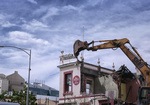We’re losing our built heritage

Victoria’s population is growing at the rate of over 1500 people a week, and this is partly fuelling the level of property price increases and putting pressure on our existing suburbs. As a result, a lot of discussions in the past few years that I’ve been part of have centred on the importance of preserving our older buildings whilst still endeavouring to fit our bulging population within existing infrastructure, and the overwhelming sentiment is that we seem to be knocking over some beautiful older, character homes and commercial buildings to make more use of the landmass.
Now, some people might see my commentary as slightly hypocritical, as my role as an advocate involves advising on development potential of properties I research for my clients, but our history is not so vast that we can knock over precious older buildings at will. We are comparatively a very young society where there are fewer older buildings (than most European nations for example) which can be considered to keep our heritage if we were to bowl them over to redevelop higher density living environments, so we should be able to find some sort of happy medium between what is architecturally or culturally significant and what is economically obsolete to the extent that development can be substantiated.
Heraclitus, a Greek philosopher, is quoted as saying “change is the only constant in life.” And in pure terms he is right, if we were the same person today as we were say, 20 years ago, we’d be pretty disappointed in ourselves; and as a society we have to keep evolving, but this evolution should not come at the cost of removing large chunks of our built history purely to increase population density in older areas so that governments can save on infrastructure spending in newer, developing areas – yes, the argument is greater than this however it is a very salient point – there has to be balance. Heritage Victoria and associated bodies can only do so much with listing of those buildings they consider to be meritorious however there are a high proportion which get missed from their listing.
In my own area of the City of Port Phillip, I’ve watched in disappointment the loss of once beautiful homes and commercial buildings being demolished and replaced by some aesthetically unattractive apartment blocks; but I’ve also seen some great examples of preserving the facades and interior spaces whilst developing higher density, modern and efficient residential and commercial spaces around them. It should incumbent on the planning authorities to take into greater account economic alternatives to the removal of homes within a development site, and to take greater note of the voices of the community in terms of what is considered significant locally. Certainly, there are some houses (mainly) where to restore or renovate them would not be feasible, but there are more often others where purely because of the landmass, the desire for profit from a multi-dwelling development overrides the historic value to the community as a whole.
If we continue to demolish and rebuild on the footprint of the “old”, without having regard for what we are handing on to future generations, we run the risk of denying them the opportunity to appreciate and understand their history.

